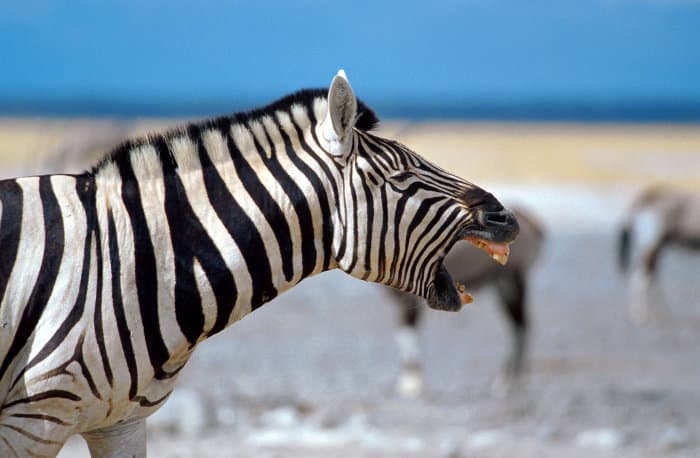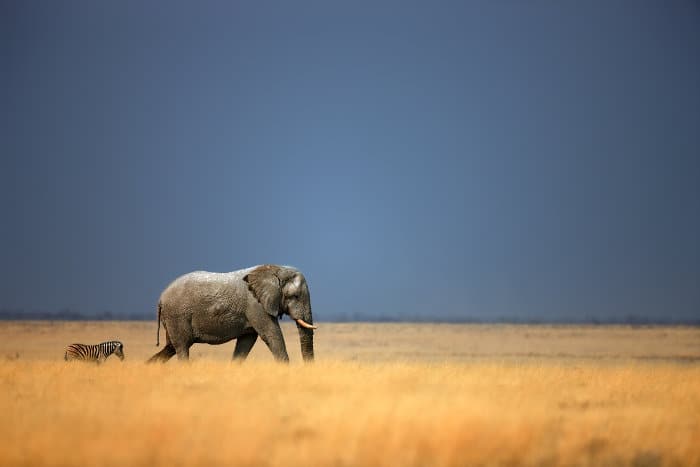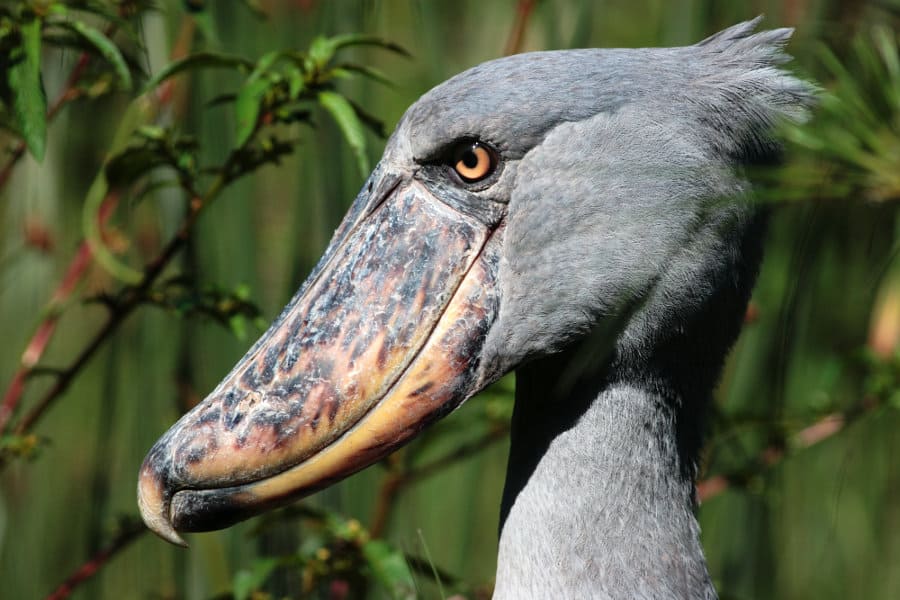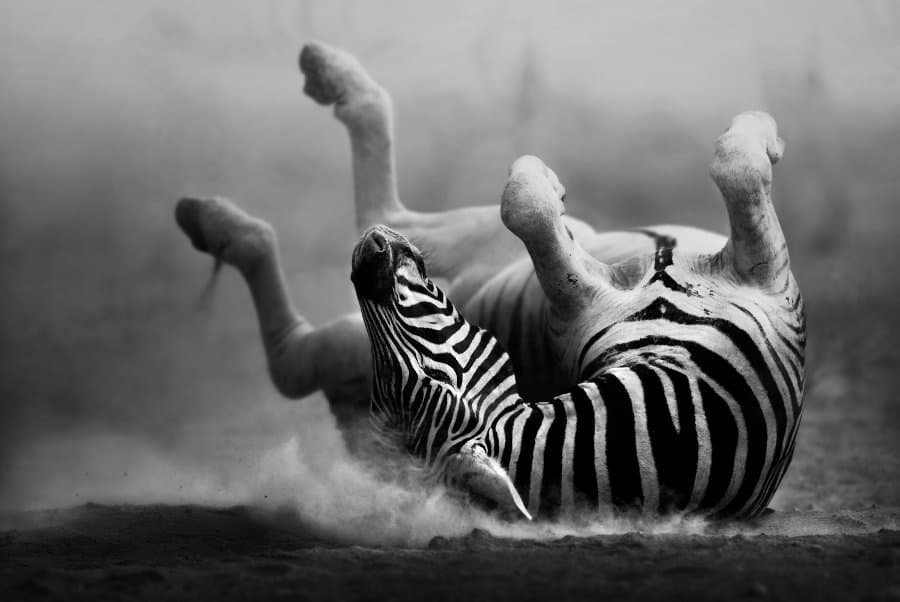Zebras are an abundant feature of the African landscape.
They hang around in herds, and sometimes even migratory super herds of thousands of members.
You’ll often see them grazing the African savanna, intermingling with wildebeest and impala.
While the bush is alive with the wild sounds of its many inhabitants, zebras are usually quiet, focused on their main task of munching grass.
However, zebras do indeed produce noises that are fundamental to their social interactions. Some of them are very close to what horses sound like, yet they also have a very distinct high-pitched noise that makes them unique.
Generally speaking, zebras either bark, bray, or snort. Such sound signals may express alertness, curiosity, or used as a greeting, to show impatience or anger.
Depending on the pitch and intensity, zebra sounds can either signify a friendly ‘hello’ or a threatening ‘back off’.
If you’re asking, what sound does the zebra make? You’ve come to the right place. Check out everything you need to know about zebra noises.
Different Zebra Sounds

Each sound of a zebra has a function to communicate with the herd or individuals within the herd.
Is there a lion lurking in the long grass, looking for an unaware meal? Cue warning snorts to alert the rest of the herd.
Is a group of females trotting past? Listen for a male’s best bray to get the attention of the ladies.
Let’s take a more in-depth look at zebra sounds.
Barking

Zebras vocalize a distinct, high-pitched barking sound to communicate with each other. Imagine a small dog yapping at the feet of its owner – it’s pretty similar to that.
This zebra sound is a greeting, the standard noise for saying hello to a newcomer or herd member. They will also use it to get a herd mate’s attention.
Braying
This noise is akin to the sound that donkeys make. This is not surprising, considering the zebra is part of the same Equidae family.
Much like its domesticated cousins, each zebra’s bray is different. Some are low baritones others are high-pitched, and they can be loud or soft.
These braying noises are a way of communicating with their mates. As well as to show frustration or anger, zebras bray, starting in a low growl-like sound which becomes louder and more high-pitched.
It’s telling that the same sound that a zebra makes to talk to their mate is also the sound that communicates their impatience.
This is one of the most important noises that a zebra makes because they use it to communicate over long distances. This is particularly useful when it comes to finding a potential mating partner.
Snorting
This is not a very polite noise, yet it’s common with donkeys and horses too. And although it sounds rude, it can be a friendly greeting given by a happy zebra.
Snorting can also be a warning to unwelcome herd guests. It’s all about context, and hopefully, there are fewer misunderstandings than one might imagine.
Would you like to find out what makes them so unique? Click on the “play” button below to listen to the sound a zebra makes. Can you figure out what they’re trying to communicate?
More Zebra Sound Effects
Check out these different zebra noises and hear the array of vocalizations that these seemingly quiet animals make.

Zebra Sound 1
Zebra Sound 2
Zebra Sound 3
5 Zebra Fun Facts

There’s more to zebras than just the sounds that they make. Here are five fun facts to learn more about these African grazers:
1. Are zebras black with white stripes or white with black stripes? This has been a much-contested subject amongst amateur bush enthusiasts and scientists alike.
After recent research on the embryological development of zebras, this argument has a clear result.
Zebras have black skin underneath their stripey white fur covering.
2. Although they seem quite docile, zebras can be aggressive and will administer a powerful kick if threatened. So what noise does a zebra make when it’s angry? Listen for a bray or a snort.
3. Zebras are essential for promoting the growth of new grass on the African plains. Their digestive systems can process old, poor-quality grass, unlike wildebeests.
When a herd of zebras grazes their way through the old stuff, it clears the path for healthy grass to sprout.
4. The common collective noun for a group of zebras is a ‘herd’. However, you can also use the jazzier word ‘dazzle‘. And it is quite dazzling to see hundreds of the monochrome animals.
5. Zebras can run up to 40 mph and will reach these speeds while trying to outrun predators. They will also run in a zig-zag fashion to outwit the big cat or wild dog pack that is chasing them.
What Sounds Do Other Animals Make?

Zebras are just one part of the wild African orchestra.
There’s always another noise to enjoy when you’re on an African safari. Whether it’s elephants blowing their trumpets or lions grunting from three kilometers away.
Now you know what sound a zebra makes, check out some of the other interesting sounds:
- What sound does a lion make?
- What sound does a leopard make?
- What sound does a cheetah make?
- What sound does an elephant make?
- What does a hippo sound like?
- What sound does a rhino make?
- What sound does a buffalo make?
- What sound does a giraffe make?
- What sound does a gorilla make?
So What Does a Zebra Sound Like?
Despite seeming like quiet and docile creatures, zebras use a bunch of noises to communicate. These beautiful striped grazers are prolific in the bush, and you have high chances of seeing them in significant numbers.
If you’re eager to hear what a zebra noise actually sounds like, book a safari and go find out for yourself!
Of course, you’ll have to listen closely to hear the sounds of zebras as they vocalize only when necessary.




Thank you.